Boquerones, Fresh Cured Anchovies
July 24, 2014 | Updated March 31, 2022
As an Amazon Associate I earn from qualifying purchases.
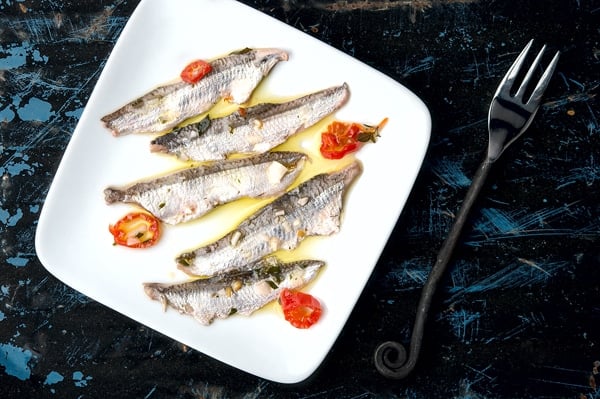
Anchovies are a polarizing ingredient, and here in the United States the battle lines are typically drawn over their presence or absence atop a pizza. Occasionally skirmishes will also break out over whether anchovies belong in a Caesar salad; apparently not, at least in its original incarnation.
But these fights are over are traditionally cured anchovies, which are a warm, lovely brick color when properly cured. These anchovies come in cans, soaked in olive or soy oil, or are sometimes packaged in little jars, encrusted with salt.
They are, alas, the only sort of anchovies most North Americans ever see. And while they can be good — really good in some cases — a far more delicate delight is the “fresh cured” anchovy, known in Spain as boquerones, in Greece as gavros, and often as “white anchovies” here in the United States.
I was an adult when I first encountered boquerones, lined up like little sardines in a tub in the deli section of a glitzy market called Agata & Valentina on the Upper East Side of Manhattan, back in about 1995. They were labeled as “fresh white anchovies,” but they sure looked cured. I asked the woman behind the counter if I could taste one. Miraculously she said yes — there is a tradition in the New York metro area of people “sampling” their way through places like these, essentially eating their lunch for free.
The fish was certainly not fresh. Eating one I got a big hit of lemon and vinegar, then salt, then garlic, then herbs. The anchovy itself was indeed white, “cooked” like a ceviche, firm and shockingly un-fishy. I mean yeah, you know you’re eating a fish, but regular anchovies can be so fishy-salty they’re off-putting. Not these.
I bought a half pound, and my then-wife and I ate them at one sitting, on crackers with some white wine. A romantic moment in our short little marriage.
Since then I eat them whenever I see them, and have made boquerones (bo-keh-ROAN-es), the name I see most often, at home several times. It is an easy process… if you can get fresh anchovies.
There’s the rub. Anchovies spoil faster than any other fish I know of. Faster than herring, faster even than sardines. So getting fresh ones is a task, and is the biggest stopper for making boquerones at home. I have seen them in fish markets, sometimes at Whole Foods, sometimes at really good local markets, and sometimes at Asian markets.
But honestly? The best way to get fresh anchovies is to find a bait shop near the Atlantic or Pacific Ocean. There’s one in San Francisco that supplies the fishing fleet in the Bay Area.
This is where I got my anchovies. Not too long ago, I was fishing for California halibut with my friend Jay Lopes of Right Hook Sportfishing and we motored over to get some bait before we hit the bay. Halibut and stripers love nothing more than to eat live anchovies. It happened to be a slow day, although I did catch a decent striped bass. No halibut, though.
But I did bring home the leftover bait, about five pounds of live anchovies, so I was more than happy.
Besides, it’s just not possible to get anchovies fresher than this, and they were gorgeous.
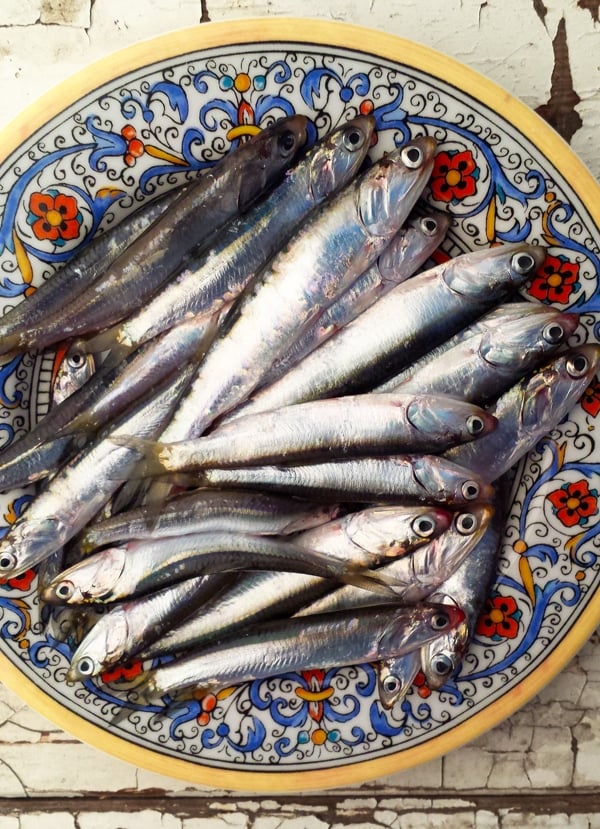
If you have to buy anchovies in a market, look at their bellies: Sardines, anchovies and related fish get what’s called “belly burn” rapidly after being caught. The enzymes in their guts start to dissolve the fish itself. This first manifests itself in broken bellies. The fish can still be OK to eat at this point, but they will not have much time left.
To make boquerones, you must clean your anchovies. This is a bit of a pain. Fortunately here is a video on cleaning anchovies, which I suggest you watch before starting. It will take about 45 minutes to clean a couple pounds of anchovies.
You can cure them with their backbones left in, but they are not as easy to eat.

Once cleaned, you salt the anchovies down for a few hours, then rinse and soak in lemon juice (Greeks seem to do this most often) or vinegar (the Spanish way). The salt draws out some moisture from the fish and firms them up, while the acid “cooks” the anchovies like a ceviche.
To store, you layer them in a lidded container with garlic, chiles and herbs and cover them with olive oil. Kept in the fridge, they will keep for more than a month.
It isn’t likely that they will last this long, however. White anchovies are addicting when eaten on crackers (I like Carr’s table water crackers the best for this.) either as a snack or as an appetizer course. I love them so much I tend to fish the San Francisco Bay not so much for the halibut or striped bass — don’t get me wrong, I want to catch them, too — as for the bait.
Jay thinks I’m crazy. That’s OK. I hear that a lot.
Boquerones, Fresh Cured White Anchovies
Ingredients
- 2 pounds anchovies, cleaned
- 3/4 pound kosher salt (roughly)
- 1 cup red wine vinegar or lemon juice, or sherry or white wine vinegar
- 6 garlic cloves, minced
- 3 tablespoons parsley, minced
- 1 to 5 small hot chiles, sliced thin (optional)
- 1/2 cup olive oil
Instructions
- Keep the cleaned anchovies whole for now. You can pull the two little fillets apart when you are ready to serve your boquerones. Lay down the salt in a wide, lidded, non-reactive container; I use a tupperware. Lay down a layer of anchovies, then sprinkle salt over them. Repeat until you have all the anchovies in the container. Finish with the rest of the salt. Jiggle the container a bit to let things settle, then cover it and put it in the fridge for 3 hours.
- Remove the anchovies and rinse them quickly under cold water. Set them in another container like your first one. When they are all nicely rinsed, cover the fish with the vinegar or lemon juice. They need to be fully submerged, so use as much as you need. Cover and refrigerate overnight.
- The next morning, remove the anchovies from the vinegar. Toss the vinegar. Now find a final resting place for your anchovies, some lidded container that you can keep in the fridge for a few weeks. Pour a little olive oil into it, then line the container with a layer of anchovies. Sprinkle a little of your seasonings over that layer and repeat until you are done. The anchovies need to be completely covered in olive oil or they will spoil. You can eat them after a few hours, but they are better after a few days or even weeks. Mine have lasted 6 weeks before getting a little janky.
Notes
Nutrition
Nutrition information is automatically calculated, so should only be used as an approximation.

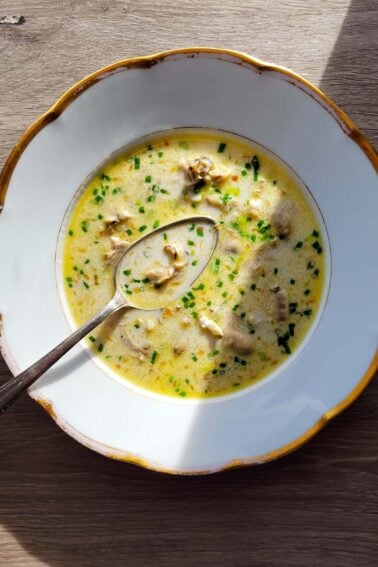

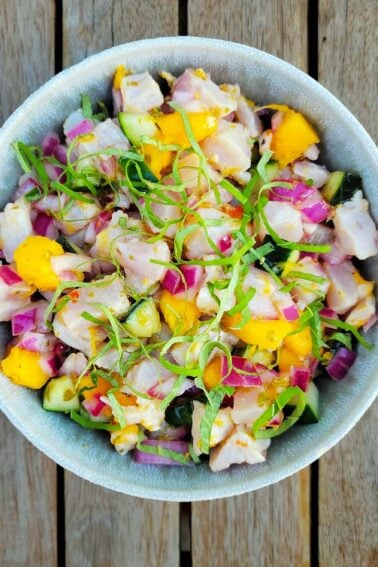
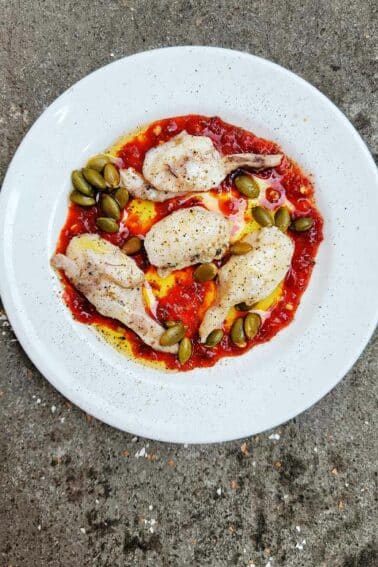
Hi Hank,
I soaked my anchovies in the lemon juice and vinegar over night. They are turning whitish on the outside and are still somewhat pink/their original color in the middle…they are also a little tough to pull off of the bone. Should I leave them in there for longer and should I be concerned with fully cooking them in the juice or not?
Thanks!
Matt
Matt: Leave them in a bit longer.
Just did these, in lemon juice. Delicious!
What happened with your garum/liquamen? I have a half-quart fermenting in the back yard just now…
Paul: I could never get it to clear. I have since learned you need to let it drip through a coffee filter for many hours. I was impatient before.
Been doing boquerones for years and my family, friends and their friends simply cannot have enough, I make sure I always have ample stock in the ref (divided into small containers) for those instant get-togethers and emergency calls in the night! I also have different variants: plain, with feta cheese, with capers, and feta+capers
And now there is also a shirt for Boquerones lovers 🙂
https://bevver.com/products/boquerones-shirt
is there a post on the fish sauce?
Leah: Nope. I haven’t developed a foolproof method of making it yet.
Hank,
I grew up in Spain and my mom and grandmother make these all the time. Now I’m in Duluth, MN and we have access to really fresh herring, locally caught right off the boat.
Anyway, I followed your recipe and it was really great…I even cut the herring into smaller strips to mimic the look of white anchovies, kind of a “faux”querones. Overall really good, the only noticeable difference was really the firmer texture of the herring vs. the more delicate meat of the white anchovy.
Cheers,
Troy
YES I love boquerones. My fishmonger had smelt last week so I will go back and try this with them if they are still there. Also looking forward to hearing your fish sauce story.
Yes, eat anchovies!
Would you mind sharing the name of the bait shop in SF? And do you know of any similar bait shops further north in Oregon or Washington? As you mention in the post, limited access to fresh anchovies is one of the main obstacles!
Unfortunately I don’t know it! We all get our anchovies from the water – we pull up to the dock and buy big scoops of them. The shop is on the Bay side of SF, though, I can tell you that.
This really looks awesome, and definitely something I want to try, especially the fish sauce part (its impossible to find kosher fish sauce so I would love to make it myself) can you give us at least a teaser on how you’re planning on making the sauce do we don’t have to wait until September?
Sure. Crush up anchovies or sardines and add salt. Put in a jar and let it ferment for months outside or at room temps.
I’ll have to try it with eulachon/hooligan next spring. They are not as earthy as anchovies, but are more oily.
Dinner from the bait shop? Love it! Great post – I’ve heard about anchovies as a sustainable seafood choice for a long time, but I just couldn’t imagine learning to enjoy those fishy things from in a can. These I think I could love.
Wondering if this would work with smelt? Similarly to Ricardo, we typically fry them here in Minnesota, but I would think they would cure up as well. Worth a shot anyway.
Will: I am pretty sure it will work with smelt. The flavor will be different, but yeah, definitely worth a shot.
Joan Carol: Snapper blues are a lot bigger than anchovies, but if you treat them like big sardines they should work. You’ll need to bone them, and I’d salt them for an extra hour or two, also.
Husband just brought home a bunch of snapper blues–baby bluefish.
We love them just fried, but I may try this with the next batch, if they’re not too big.
I think I could eat my weight in anchovies! Love this post and now I’m determined to catch myself some anchovies so I can make these. On occasion, very rarely, I can find them at my local fish market. Thanks for the recipe!
Those fish look a little like the shiners that we caught off the pier in Sechelt for use as bait for rock cod.
I went fishing out of Santa Cruz harbor last Friday, ½ mile out the harbor there was a huge school of anchovies. Had the kids jig some up and they made great bait for some rockfishing. An even easier way to pick them up is head down to the dock and Bocci will sell you scoop. Thanks for the recipe, looking forward trying it out.
Sounds like something worth to try.
Say, Hank, do you know what is the name of the little fish you find in the rivers of Texas and Noreasthern Mexico. Here we call them sardines, and the few people that catch them with a bottle use them as bait, or fry them until cruncy, also known as “charales”. Maybe they could be cured with this recipe.
I never really appreciated anchovies until I had my first Boquerones, now they are all I will eat. If you don’t have access to fresh fish you can buy some very simply cured Boquerones packed in Olive oil from Earthy Delights (https://www.earthy.com/). Simply pick up the recipe at Step 3.
What a fun post. Takes me right back to Greece. And it makes me wonder why I didn’t learn to make these then, when I spent most of my summer in the islands? Better late than never.
Wow, that is making my mouth water! I’m tired of my father-in-law’s pickled fish, he always buys the cheap stuff. I wish I’d known how to do this back when I lived in California, seemed like there was always a good supply of leftover bait…